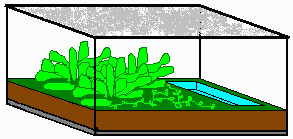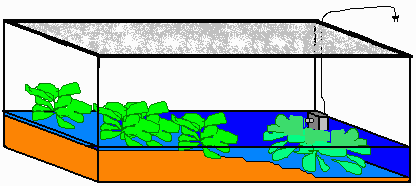![[Bombina orientalis]](fb_tiny.jpg)
Caging
When designing the living quarters for a new colony of firebellied toads, one must consider the needs of the toads. Generally speaking, the enclosure of choice for firebellied toads is a glass aquarium which can be purchased new at any pet store or used (often quite cheaply) through classified ads. If purchasing a used tank, be sure that it will not leak water. Such a tank can then be converted into a type of terrarium called a vivarium (plural vivaria). The only difference between a terrarium and a vivarium is that the latter contains both animal and plant life, as opposed to only plants.
Three oriental firebellied toads can be comfortably housed in a ten gallon tank, with at least four to five gallons more added for each additional toad. Do not take the previous statement to mean that a single toad would be comfortable in a five gallon tank. A ten gallon tank is the minimum amount of space required for a single toad, and certainly, the more space that one can provide the toads, the healthier they will be. Horizontal tank space is much more important than vertical space, and a number of aquaria are designed with a large horizontal footprint. Such tanks are generally described as 'long' tanks, as in a '20 gal long' aquarium. Often times, simply trading up in terms of volume will not increase the size of the tank footprint, only the price, so it pays for the owner to determine the linear dimensions of a tank before purchasing it.
In addition to the tank itself, the caging setup will require a surface strong enough to support the weight of a full tank, which can be considerable. A cover for the cage is essential, due to the ability of firebellied toads to climb the walls of their vivarium by sticking their bellies into the corner of the tank and squirming their way aloft. The best sort of cover for a frog tank is a fine-mesh metal screen set in a plastic frame with locking pins. Such a cover can be found in many pet stores and also provides the benefit of keeping pets and children out of the cage. Lighting and heating are necessary as well, and will be addressed in a later segment. Finally, while live plants are not required, they do much for the aesthetics of the environment and are strongly recommended. In the absence of plants, artificial visual blocks are needed to provide the toads will hiding areas.
There are two general approaches to designing vivaria for firebellied toads. The first is the forest floor vivarium. This tank simulates a mossy part of the forest floor complete with low-growing plants. Water is provided through a dish sunk into the surface of the ground. Such a tank will discourage breeding if not outright prohibit it, as toads need a large water space to breed successfully. Unless they are prepared to raise young toads and tadpoles, the novice keeper should probably choose the forest floor vivarium. If on the other hand, the keeper wishes to eventually breed their toads, they should construct a semi-aquatic tank setup. Such a tank is generally divided into approximately 2/3 shallow water and 1/3 dry land. The choice of vivarium is an important one to make prior to purchasing one's tank.
| Examples of Vivarium Setups
|

| 
|
| Forest Floor
| Semi-Aquatic
|
Note on Multi-Species Tanks
Mixing different species in a vivarium is to be highly discouraged. For the novice especially, it is often difficult to predict the compatability of the various species and it is often difficult to provide for each of their needs. Size differences in adults can lead to predation on tank mates or the constant stress caused by fear of more active tank mates. Toxicity or disease can sometimes become a problem. Oftentimes, the problem is as simple as conflicting environmental requirements. I have often seen Anolis lizards or White's Treefrogs Litoria caerulea kept with firebellied toads. Anolis lizards require drier and more arboreal setups than firebellied toads, and may even attempt to eat the toads. White's treefrogs grow to large sizes, also require much more dry and arboreal tanks, and they will also take a shot at eating a firebellied toad. While it is possible to keep very similar species together quite successfully, unless the keeper is certain of the combination, they should avoid the practice of keeping multi-species tanks.
Previous Page - -
Main Page - -
Next Page
![[Bombina orientalis]](fb_tiny.jpg)
![[Bombina orientalis]](fb_tiny.jpg)

